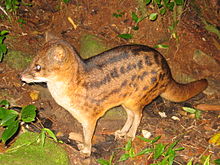Fanaloka
| Malagasy civet | |
|---|---|
 |
|
| Malagasy civet at Ranomafana National Park. | |
| Scientific classification | |
| Kingdom: | Animalia |
| Phylum: | Chordata |
| Class: | Mammalia |
| Order: | Carnivora |
| Family: | Eupleridae |
| Subfamily: | Euplerinae |
| Genus: |
Fossa Gray, 1864 |
| Species: | F. fossana |
| Binomial name | |
|
Fossa fossana (Müller, 1776) |
|
 |
|
| Malagasy civet range | |
The Malagasy or striped civet (Fossa fossana), also known as the fanaloka (Malagasy, [fə̥ˈnaluk]) or jabady, is an euplerid endemic to Madagascar.
The Malagasy civet is a small mammal, about 47 centimetres (19 in) long excluding the tail (which is only about 20 centimetres (7.9 in)). It can weigh 1.5 to 2.0 kilograms (3.3 to 4.4 lb). It is endemic to the tropical forests of Madagascar. Malagasy civets are nocturnal. It eats small vertebrates, insects, aquatic animals, and eggs stolen from birds' nests. The mating season of the Malagasy civet is August to September and the gestation period is three months, ending with the birth of one young. The Malagasy Civet is listed as Vulnerable by International Union for Conservation of Nature (IUCN).
The Malagasy civet was to be placed in the subfamily Hemigalinae with the banded palm civets and then in its own subfamily, Fossinae, because of similarities with others in the group pointed out by Gregory, but it is now classified as a member of the subfamily Euplerinae, after Pocock pointed out more similarities with that one.
The Malagasy civet is a small mammal, about 47 centimetres (19 in) long excluding the tail (which is only about 20 centimetres (7.9 in)). The males can weigh up to 1.9 kilograms (4.2 lb), and the females can weigh up to 1.75 kilograms (3.9 lb). It is the second largest carnivore in Madagascar after the fossa. Its head is about It has the appearance and movements of a small fox. it may be confused with the small Indian civet (Viverricula indica). It has a short coat greyish beige or brown in colour, with dark black horizontal stripes running from head to tail, where the stripes are vertical, wrapping around the bushier tail. The stripes morph into spots near the belly. Its legs are short and very thin.
...
Wikipedia

